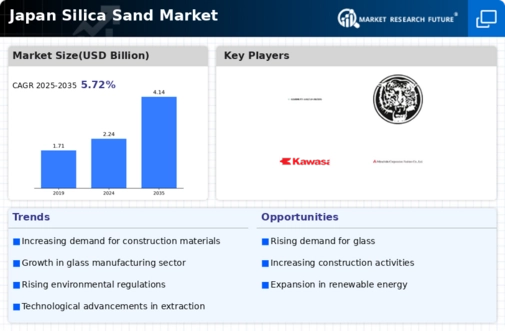The Japan Silica Sand Market is characterized by its diverse range of players and competitive dynamics that shape the industry landscape. As a key component in various sectors, including construction, glass manufacturing, and foundry applications, silica sand's demand is influenced by economic trends, shifts in consumer preferences, and technological advancements. Companies operating in this market strive to establish a stronger position by leveraging specific strengths, including operational efficiencies, innovative processing methods, and strategic partnerships.
Continuous advancements in extraction and processing technologies also play a pivotal role in enhancing product quality and operational capabilities, which in turn impacts competitive positioning among various players in the market. The increasing focus on sustainability and environmental regulations adds another layer of complexity, prompting firms to adopt eco-friendly practices that align with contemporary market expectations.
Sanden Holdings Corporation stands out as a significant player within the Japan Silica Sand Market, showcasing robust capabilities and a strong market presence. The company has established itself as a reliable supplier of premium silica sand, which is essential for various industrial applications. With a commitment to quality and efficiency, Sanden Holdings Corporation has developed advanced processing techniques that allow for the production of high-grade silica sand, catering to the evolving demands of its clientele.
This dedication to excellence, coupled with a comprehensive understanding of local market dynamics, enables the company to maintain a competitive edge and capitalize on emerging opportunities. Sanden Holdings Corporation's strategic alliances and industry partnerships further reinforce its position in the market, driving innovation and contributing to enhanced operational efficiency.
Aqua Minerals plays a vital role in the Japan Silica Sand Market, recognized for its distinct products and services tailored to meet the specific needs of various industries. The company specializes in providing high-quality silica sand that is primarily utilized in construction, environmental applications, and water filtration systems. Aqua Minerals' commitment to sustainability is reflected in its eco-friendly extraction methods and processing techniques, ensuring minimal impact on local ecosystems. The company has made strategic advancements through mergers and acquisitions, allowing it to expand its product offerings and enhance its market presence within Japan.
Furthermore, Aqua Minerals' focus on research and development has positioned it as an innovative player capable of adapting to market changes and technological advancements, giving it a strong competitive advantage in the silica sand sector. By emphasizing quality, sustainability, and operational excellence, Aqua Minerals continues to solidify its reputation as a leading provider in the Japan Silica Sand Market.















Leave a Comment